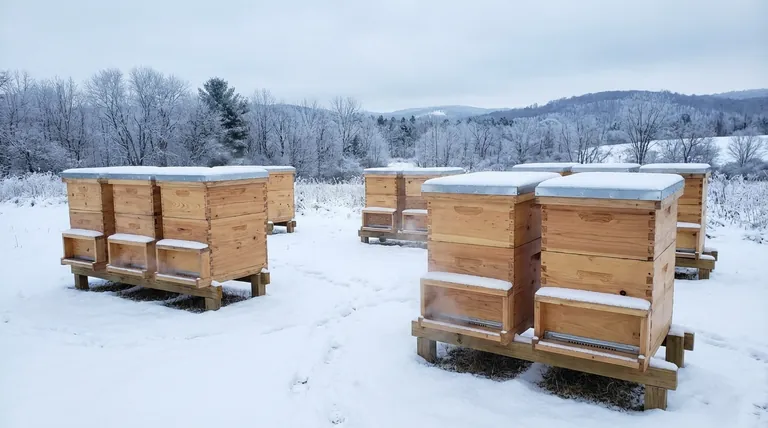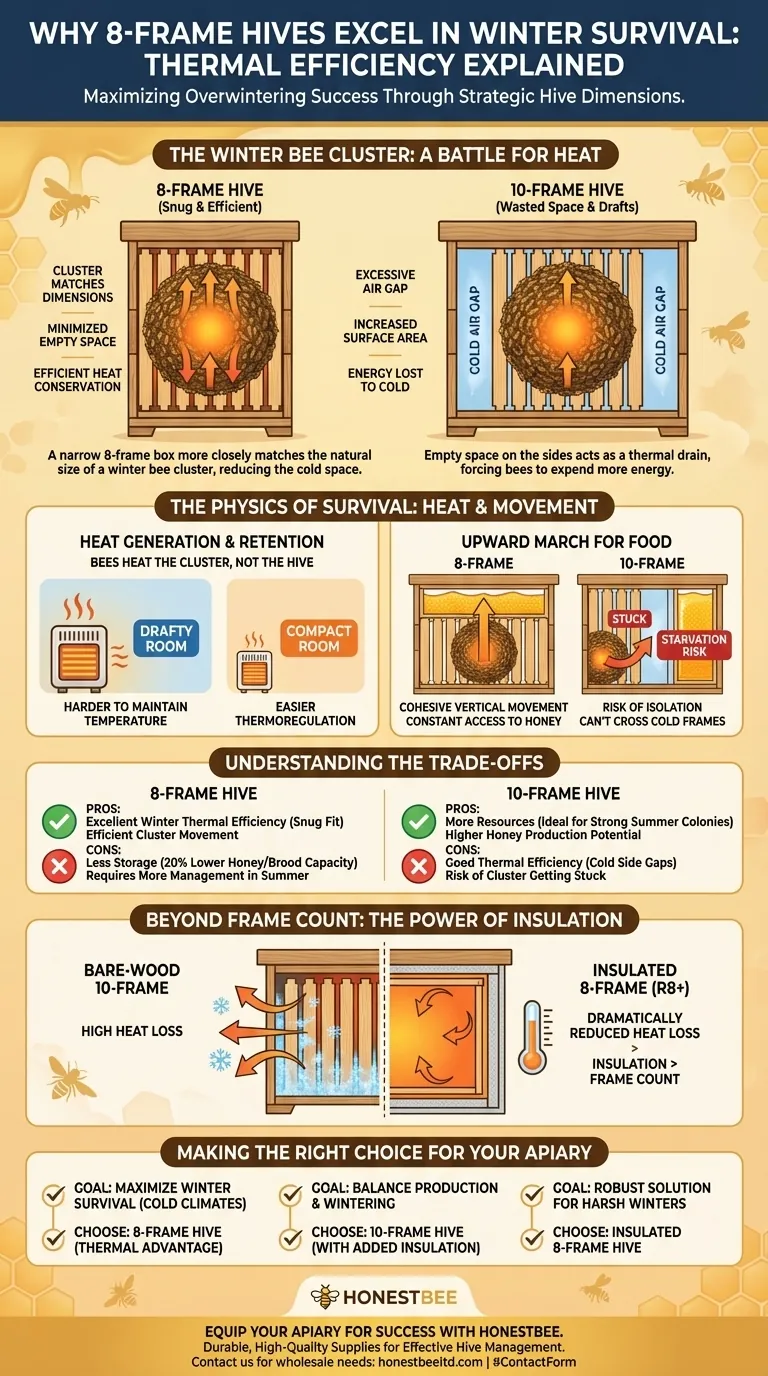In the challenge of overwintering honeybees, an 8-frame hive is often considered superior for winter survival due to its thermal efficiency. The narrower dimensions of an 8-frame box more closely match the natural size of a winter bee cluster, reducing the empty, cold space the colony must heat. This allows the bees to conserve energy and move upwards toward their honey stores more effectively as a cohesive unit.
The primary reason 8-frame hives can improve winter survival is not the number of frames itself, but how their narrower dimension aligns with the natural shape of a winter bee cluster. This minimizes wasted space and promotes efficient, life-sustaining movement towards food stores.

The Physics of the Winter Cluster
To understand why hive configuration matters, you must first understand the bee's strategy for survival. Bees do not heat the entire hive; they only heat their cluster.
How Bees Generate Heat
Bees form a tight ball, with a dense outer "mantle" of bees insulating an inner core. Bees in the core generate heat by vibrating their wing muscles, producing the energy needed to keep the center of the cluster at a stable, warm temperature, even when it is freezing outside.
The Problem of Unused Space
Any empty space inside the hive is a liability. The larger the air gap between the cluster and the hive walls, the more energy is lost to the cold. This is like trying to heat a large, drafty room with a small space heater; the heater works constantly but struggles to maintain the temperature.
A smaller cavity means less surface area for heat to radiate away, making the bees' job of thermoregulation significantly easier and more energy-efficient.
Hive Configuration and Thermal Efficiency
The design of the hive directly impacts the cluster's ability to manage its heat and access food. This is where the 8-frame configuration provides a distinct advantage.
Why 8-Frames Align with Cluster Shape
A typical winter cluster naturally spans about 8 frames in width. In a 10-frame box, this leaves an empty, cold frame on either side of the cluster. These gaps act as thermal drains, forcing the bees to expend more energy to maintain their core temperature.
An 8-frame box eliminates these side gaps, creating a "chimney effect." The cluster fits snugly, and the heat it generates rises, warming the frames of honey directly above them.
The Upward March for Food
As winter progresses, the cluster consumes its honey stores and must move to access more. In a Langstroth hive, this movement is almost always upward.
The snug fit in an 8-frame hive encourages the entire cluster to move vertically as one unit. This ensures the colony stays in contact with its food supply throughout the winter.
The Danger in 10-Frame Hives
In a wider 10-frame box, a smaller colony might get "stuck" on one side. The bees can be reluctant to cross cold, empty frames to reach honey on the other side of the box. This can lead to a tragic scenario where a colony starves to death just inches away from a full frame of honey.
Understanding the Trade-offs
Choosing an 8-frame hive for its winter benefits is not without compromises. A trusted advisor must present the full picture.
The 8-Frame Disadvantage: Less Storage
The most significant trade-off is reduced space. During the peak summer season, 8-frame boxes hold 20% less honey and provide less room for the queen to lay eggs compared to 10-frame equipment. This can mean smaller populations and lower honey yields without diligent management and more frequent supering.
The 10-Frame Advantage: More Resources
A strong colony in a 10-frame hive can store more resources for winter, providing a larger buffer. In regions with milder winters or for beekeepers focused on maximizing honey production, the 10-frame standard often remains the more practical choice.
Beyond Frame Count: The Role of Insulation
Hive configuration is only one piece of the puzzle. As noted in studies on polystyrene hives, insulation can be an even more powerful factor. A well-insulated 10-frame hive can easily outperform a bare-wood 8-frame hive by dramatically reducing overall heat loss. Adding foam board insulation or using insulated hive bodies (which can have an R-value of R8 or higher) reduces the energy burden on the bees, regardless of frame count.
Making the Right Choice for Your Goal
Your decision should be based on your specific climate, management style, and beekeeping objectives.
- If your primary focus is maximizing winter survival in a cold climate: An 8-frame hive offers a clear thermal advantage by better matching the cluster's natural dimensions.
- If your primary focus is balancing strong honey production with reasonable winter success: A 10-frame hive may be more efficient during the summer, but you must ensure it is packed with bees and consider adding insulation for winter.
- If you want the most robust solution for a harsh winter: Combine the principles by using an insulated 8-frame hive to give your colony the greatest possible advantage.
Ultimately, successful overwintering comes from understanding the principle of thermal efficiency, not just from the equipment you use.
Summary Table:
| Feature | 8-Frame Hive | 10-Frame Hive |
|---|---|---|
| Winter Thermal Efficiency | Excellent (fits cluster snugly) | Good (can have cold side gaps) |
| Cluster Movement | Efficient upward movement | Risk of getting "stuck" on one side |
| Honey/Brood Storage | Lower (20% less than 10-frame) | Higher (ideal for strong summer colonies) |
| Ideal For | Maximizing winter survival in cold climates | Balancing honey production & wintering |
Equip Your Apiary for Success with HONESTBEE
Ready to give your colonies the best chance at thriving through winter? HONESTBEE supplies commercial apiaries and beekeeping equipment distributors with the durable, high-quality supplies needed for effective hive management.
We understand the critical balance between winter survival and honey production. Let us help you select the right equipment—from 8-frame hive bodies to insulation solutions—to meet your specific operational goals.
Contact HONESTBEE today to discuss your wholesale needs and build a more resilient beekeeping operation.
Visual Guide

Related Products
- Langstroth Bee Hives Bee Keeping Box for Beginners Beekeeping
- Professional Insulated Winter Hive Wrap for Beekeeping
- Professional Hive Top Bee Feeder for Beekeeping
- HONESTBEE Professional Long Handled Hive Tool with Precision Cutting Blade
- Professional Insulated Plastic Bee Hives
People Also Ask
- How does the orientation of the hive sides benefit comb construction? Ensure Straight, Movable Combs for Easier Hive Management
- How does the ease of access differ between 8-frame and 10-frame hives? Choose the Right Hive for Your Body
- Why might a beginner be advised to start with a Langstroth hive? Unlock a Supportive Beekeeping Ecosystem
- Why are Langstroth hives recommended for beginners? Unmatched Support & Standardization
- Why were wooden hives traditionally preferred? For Natural Beekeeping Aligned with Bee Biology



















